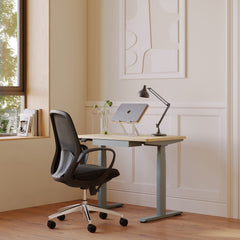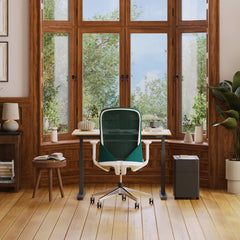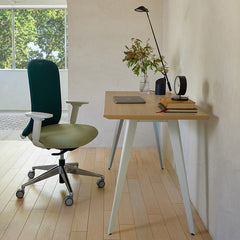Get 10% off your first order
Find the office furniture that’s designed to match your style, comfort, and needs perfectly. Subscribe
Space Shift: The Art of the Live-Work Fusion

Visit quiz page to see how we makes it easy to create an inspiring workplace


A clean workspace is more than just an aesthetic preference; it’s a psychological and functional advantage. Visual clutter caused by tangled cables can reduce concentration, slow cognitive processing, and create a sense of disorder that subtly undermines productivity. When employees are surrounded by unorganized cords and power lines, their eyes constantly register the chaos, dividing attention and adding unnecessary mental load.
Minimalist and well-organized office environments promote clarity and focus. Cable routing kits eliminate that visual noise by creating streamlined desk setups that direct attention back to the work itself, not the mess beneath it. In environments where teams depend on shared desks, conference pods, or open layouts, consistent cable organization reinforces collective efficiency and a sense of calm.
An organized workspace communicates professionalism and care. When visitors, clients, or partners enter an office where technology blends seamlessly into design, the impression is one of precision and reliability. Unruly cables, on the other hand, disrupt visual flow and suggest a lack of attention to detail.
For businesses aiming to align with modern design standards, cable management is no longer optional. It has become a marker of brand identity and operational pride. Clean surfaces, hidden wires, and thoughtful desk accessories make an immediate statement about the company’s culture and the value it places on well-being and order.
Cable disarray can lead to more than just visual discomfort. Loose cords often tangle around chair legs or become trip hazards in shared spaces. They also interfere with legroom and mobility, discouraging employees from using height-adjustable furniture properly. Aligning with ergonomic workspace standards from NIOSH helps ensure that cables are routed safely, promoting posture stability and reducing accident risks. Proper routing solutions contribute to both visual appeal and functional safety, enabling an environment that supports healthy work habits and smooth movement.
A well-designed cable routing kit includes multiple coordinated elements. These typically feature trays or raceways to guide wires beneath desks, clips and clamps to secure cords along structural edges, and flexible sleeves or channels to bundle cables together neatly. Quality kits are built to integrate power and data cables while maintaining flexibility for adjustments or upgrades.
Material selection plays a crucial role. Durable plastics, metal trays, or flexible polymer spines each offer specific benefits depending on the desk type and office configuration. A good kit not only hides cables but also simplifies future access for maintenance or technology updates.
Every desk setup requires a tailored approach to cable management. Sleek, minimalist furniture often calls for solutions that remain entirely hidden while preserving legroom and movement. Choosing an under-desk routing kit for invisible cable organization provides an effective way to conceal cords beneath tabletops while maintaining ventilation and accessibility.
These systems are especially valuable in workspaces where form and function meet. From executive offices to open-plan designs, they allow designers to maintain visual uniformity and ergonomic efficiency without compromising on technology access.
High-performance routing kits now emphasize sustainability, durability, and reusability. Components made from recyclable materials extend product life and support greener office initiatives. Flexible designs that allow reconfiguration are ideal for evolving offices where layouts may shift or new devices are added. Quality cable routing relies not on novelty but on smart design choices that ensure both longevity and adaptability.
In team-based settings, shared workstations often require a unified power and data strategy. Routing kits can streamline these shared connections, minimizing exposed cords between users and creating an orderly visual rhythm. A collaborative quad workstation for team efficiency is a practical example, where central routing channels distribute power discreetly to each side.
Efficient cable management also simplifies cleaning and rearrangement, which are essential for high-traffic offices. Keeping cords centralized protects them from wear while supporting a safer, more adaptable working environment.
Bigger desk systems introduce complexity in power distribution and routing. The six-person workstation designed for space harmony demonstrates how integrated cable channels and under-desk pathways prevent clutter without restricting access. These systems let users connect multiple monitors and devices seamlessly, keeping visible wiring to a minimum.
Balancing visual flow with accessibility ensures that even large collaborative desks maintain an organized appearance that supports both teamwork and focus.
Modern offices increasingly rely on modular components that can be rearranged to suit evolving needs. Integrating routing into modular office panel systems for cleaner layouts enables cables to run through partitions without breaking the design continuity. This vertical routing method keeps surfaces clear, reduces hazards, and supports both aesthetic and functional goals.
When panels double as conduits, they also contribute to sound control and spatial zoning, reinforcing both comfort and organization.
The beauty of a minimalist office lies in what isn’t seen. Exposed wires can disrupt the symmetry of a carefully arranged workspace. Cable routing systems allow power delivery and connectivity to remain invisible, preserving the integrity of design lines. A consistent and concealed cable layout maintains the architectural balance of the furniture, letting craftsmanship and material quality stand out.
Ease of access to outlets is important for functionality, yet bulky extension cords can break visual cohesion. Installing clamp-on power modules that simplify desk access provides an elegant way to bring power closer to the work surface without visible clutter. These modules attach securely to desk edges, offering convenience without compromise.
For adjustable or shared desks, vertical cable organization is essential. A flexible cable spine system for adjustable desks channels cords along the movement axis, maintaining order as desks move up or down. The spine conceals wires within a segmented, articulated form that bends smoothly, keeping pathways protected and aesthetically discreet.
| Cable Solution Type | Visual Impact | Flexibility | Ideal For | Example Use |
|---|---|---|---|---|
| Clamp-On Power | Minimal surface wiring | High | Hot desks, co-working setups | Clamp-On Desk Power |
| Under-Desk Tray | Fully hidden | Moderate | Fixed or executive desks | Under-Desk Tray System |
| Cable Spine | Vertical concealment | High | Sit-stand and shared desks | Cable Spine Kit |
| Raceway or Panel Channel | Integrated design | High | Modular offices | Panel Channel System |
Each system serves a specific purpose and can be layered for optimal results. Combining under-desk trays with vertical spines, for instance, ensures total concealment across both horizontal and vertical planes.
Cable routing is most effective when supported by thoughtful accessories. Desk grommets, docking trays, and small clamps keep everyday devices tidy while maintaining visual order. Additional solutions like monitor arms and under-desk shelves free up valuable surface area, enhancing efficiency and aesthetics simultaneously.
A curated collection of modern office accessories can elevate any setup by blending utility with design. These pieces support the same principles as cable routing: simplicity, balance, and functionality. Matching finishes and materials across accessories ensures a visually unified environment that reflects a company’s design ethos.
Effective routing begins with a clear layout plan. Identify all devices, note their power and data requirements, and map their connections relative to desk and outlet placement. Labeling cables prevents confusion and reduces downtime during reconfiguration. Pre-planning allows the chosen routing system to align perfectly with furniture dimensions and user workflow.
Proper installation is a methodical process. Secure trays or channels beneath the desk, group related cables, and fasten them with clips or sleeves. Ensure there is adequate slack to accommodate desk movement or device repositioning. Conduct a functionality test before finalizing to confirm that all devices operate properly and no wires are pinched or overly stretched.
While many modern kits support do-it-yourself installation, professional assembly may be appropriate for complex layouts or large setups that involve multiple power sources.
Technology evolves rapidly, and workspaces must adapt. Choose routing solutions that allow easy cable replacement and expansion. Regularly inspect connection points and wipe down under-desk areas to prevent dust buildup or cable degradation. Consistent maintenance ensures that the system remains reliable, safe, and visually pristine for years.
Cable clutter can impede movement, causing users to twist or reach awkwardly. Clean routing eliminates those obstructions, promoting safer sitting and standing postures. By keeping pathways clear, users move freely without tripping risks or distractions.
Height-adjustable furniture offers ergonomic benefits but introduces cable strain risks. Properly managed cables move seamlessly with the desk, preserving connectivity without resistance. Systems designed for flexibility ensure that ergonomic advantages remain intact while maintaining a tidy appearance.
Workplace comfort and organization are closely linked to long-term performance. An environment free from visual and physical clutter encourages mental clarity and sustained engagement. Employees in tidy, well-managed spaces are more likely to maintain consistent focus and creative energy throughout the day.
As workplaces continue to evolve, the goal of complete cable concealment is shifting toward intelligent power integration. Wireless charging, modular desks with embedded outlets, and hybrid connectivity systems are gradually reducing visible cables. Cable routing remains essential even in these advanced settings, ensuring safety and organization until wireless technologies become standard.
The sustainability trend is reshaping how office furniture is built and maintained. Modular components designed for reuse and recycling are becoming the foundation of modern workspace systems. Cable routing kits that can be detached and reinstalled align naturally with this principle, supporting flexible office reconfiguration without waste.
Future-forward furniture design now incorporates cable pathways within its structure. Built-in power channels, concealed USB hubs, and seamless data routing combine aesthetics with technology. These solutions balance design authenticity with practical needs, setting a new baseline for workspace cleanliness and functionality.
Cable routing kits may not be the most visible elements of office design, but their impact is unmistakable. By reducing clutter, enhancing safety, and supporting ergonomic integrity, they create environments where focus and creativity thrive. Clean lines, hidden power, and organized desks collectively define the modern professional standard—one where every element contributes to clarity, productivity, and visual harmony.

Space Shift: The Art of the Live-Work Fusion

How to Arrange Furniture to Maximize Peace

Crafting Calm: Your Guide to the Perfect Reading Corner
Get 10% off your first order
Find the office furniture that’s designed to match your style, comfort, and needs perfectly. Subscribe
Leave a comment